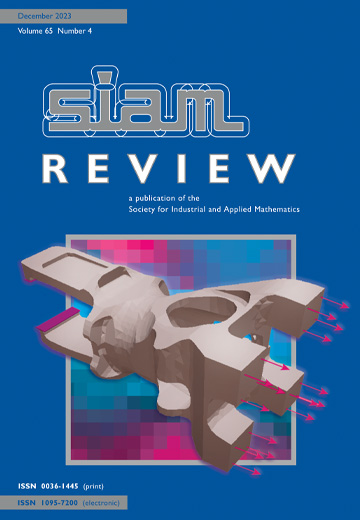贝叶斯反问题通常是好姿势的
IF 6.1
1区 数学
Q1 MATHEMATICS, APPLIED
引用次数: 0
摘要
SIAM评论,第65卷第3期,第831-865页,2023年8月。反问题描述了将数学模型与观测数据相结合的任务——这是许多科学和工程学科的基本任务。这类任务的可解性通常通过其适定性来分类。如果一个问题有一个持续依赖于输入或数据的独特解决方案,那么它就是一个好问题。反问题通常是不适定的,但有时可以通过公式化可能是适定问题的方法来处理。常用的方法是反问题的变分法和贝叶斯方法。对于贝叶斯方法,Stuart[Acta Numer.,19(2010),pp.451-559]给出了后验测度(贝叶斯逆问题的解)存在、唯一、相对于Hellinger距离是Lipschitz连续的假设,因此,是适定的。在这项工作中,我们简化并推广了这一概念:事实上,我们通过在明显较弱的假设下分别证明Hellinger距离、Wasserstein距离和总变差距离的存在性、唯一性和连续性,以及关于弱收敛性,展示了适定性。一大类实际相关的贝叶斯反问题满足这些条件。这些条件通常可以在不分析底层数学模型的情况下进行验证——该模型可以被视为黑盒。本文章由计算机程序翻译,如有差异,请以英文原文为准。
Bayesian Inverse Problems Are Usually Well-Posed
SIAM Review, Volume 65, Issue 3, Page 831-865, August 2023.
Inverse problems describe the task of blending a mathematical model with observational data---a fundamental task in many scientific and engineering disciplines. The solvability of such a task is usually classified through its well-posedness. A problem is well-posed if it has a unique solution that depends continuously on input or data. Inverse problems are usually ill-posed, but can sometimes be approached through a methodology that formulates a possibly well-posed problem. Usual methodologies are the variational and the Bayesian approach to inverse problems. For the Bayesian approach, Stuart [Acta Numer., 19 (2010), pp. 451--559] has given assumptions under which the posterior measure---the Bayesian inverse problem's solution---exists, is unique, and is Lipschitz continuous with respect to the Hellinger distance and, thus, well-posed. In this work, we simplify and generalize this concept: Indeed, we show well-posedness by proving existence, uniqueness, and continuity in Hellinger distance, Wasserstein distance, and total variation distance, and with respect to weak convergence, respectively, under significantly weaker assumptions. An immense class of practically relevant Bayesian inverse problems satisfies those conditions. The conditions can often be verified without analyzing the underlying mathematical model---the model can be treated as a black box.
Inverse problems describe the task of blending a mathematical model with observational data---a fundamental task in many scientific and engineering disciplines. The solvability of such a task is usually classified through its well-posedness. A problem is well-posed if it has a unique solution that depends continuously on input or data. Inverse problems are usually ill-posed, but can sometimes be approached through a methodology that formulates a possibly well-posed problem. Usual methodologies are the variational and the Bayesian approach to inverse problems. For the Bayesian approach, Stuart [Acta Numer., 19 (2010), pp. 451--559] has given assumptions under which the posterior measure---the Bayesian inverse problem's solution---exists, is unique, and is Lipschitz continuous with respect to the Hellinger distance and, thus, well-posed. In this work, we simplify and generalize this concept: Indeed, we show well-posedness by proving existence, uniqueness, and continuity in Hellinger distance, Wasserstein distance, and total variation distance, and with respect to weak convergence, respectively, under significantly weaker assumptions. An immense class of practically relevant Bayesian inverse problems satisfies those conditions. The conditions can often be verified without analyzing the underlying mathematical model---the model can be treated as a black box.
求助全文
通过发布文献求助,成功后即可免费获取论文全文。
去求助
来源期刊

SIAM Review
数学-应用数学
CiteScore
16.90
自引率
0.00%
发文量
50
期刊介绍:
Survey and Review feature papers that provide an integrative and current viewpoint on important topics in applied or computational mathematics and scientific computing. These papers aim to offer a comprehensive perspective on the subject matter.
Research Spotlights publish concise research papers in applied and computational mathematics that are of interest to a wide range of readers in SIAM Review. The papers in this section present innovative ideas that are clearly explained and motivated. They stand out from regular publications in specific SIAM journals due to their accessibility and potential for widespread and long-lasting influence.
 求助内容:
求助内容: 应助结果提醒方式:
应助结果提醒方式:


